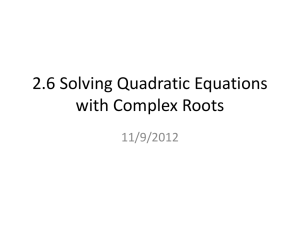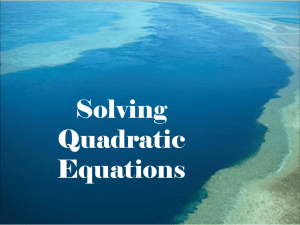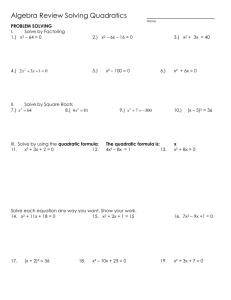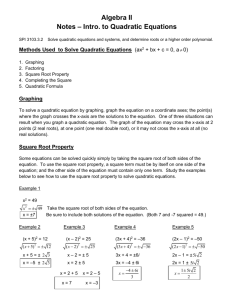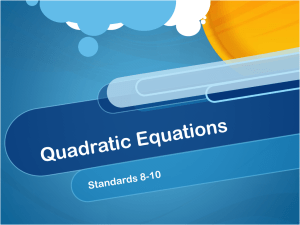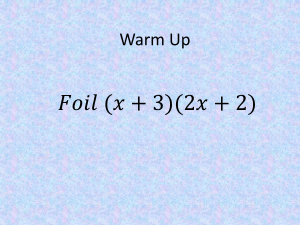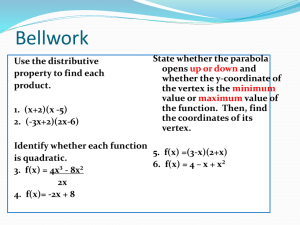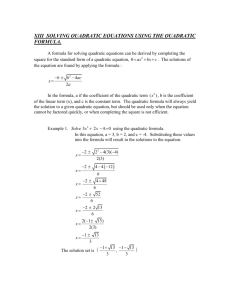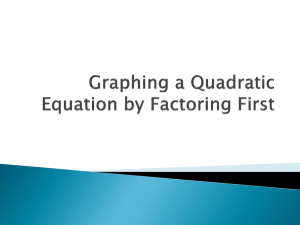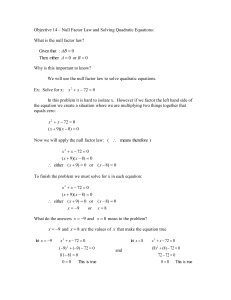Teacher created Formative Assessment
advertisement
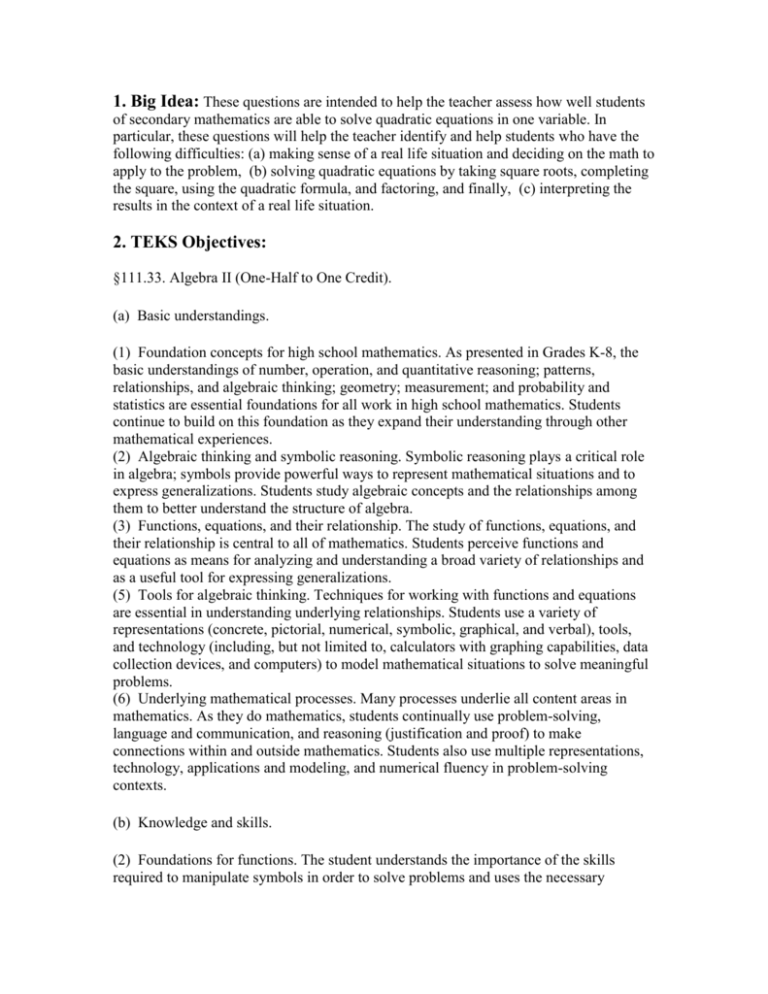
1. Big Idea: These questions are intended to help the teacher assess how well students of secondary mathematics are able to solve quadratic equations in one variable. In particular, these questions will help the teacher identify and help students who have the following difficulties: (a) making sense of a real life situation and deciding on the math to apply to the problem, (b) solving quadratic equations by taking square roots, completing the square, using the quadratic formula, and factoring, and finally, (c) interpreting the results in the context of a real life situation. 2. TEKS Objectives: §111.33. Algebra II (One-Half to One Credit). (a) Basic understandings. (1) Foundation concepts for high school mathematics. As presented in Grades K-8, the basic understandings of number, operation, and quantitative reasoning; patterns, relationships, and algebraic thinking; geometry; measurement; and probability and statistics are essential foundations for all work in high school mathematics. Students continue to build on this foundation as they expand their understanding through other mathematical experiences. (2) Algebraic thinking and symbolic reasoning. Symbolic reasoning plays a critical role in algebra; symbols provide powerful ways to represent mathematical situations and to express generalizations. Students study algebraic concepts and the relationships among them to better understand the structure of algebra. (3) Functions, equations, and their relationship. The study of functions, equations, and their relationship is central to all of mathematics. Students perceive functions and equations as means for analyzing and understanding a broad variety of relationships and as a useful tool for expressing generalizations. (5) Tools for algebraic thinking. Techniques for working with functions and equations are essential in understanding underlying relationships. Students use a variety of representations (concrete, pictorial, numerical, symbolic, graphical, and verbal), tools, and technology (including, but not limited to, calculators with graphing capabilities, data collection devices, and computers) to model mathematical situations to solve meaningful problems. (6) Underlying mathematical processes. Many processes underlie all content areas in mathematics. As they do mathematics, students continually use problem-solving, language and communication, and reasoning (justification and proof) to make connections within and outside mathematics. Students also use multiple representations, technology, applications and modeling, and numerical fluency in problem-solving contexts. (b) Knowledge and skills. (2) Foundations for functions. The student understands the importance of the skills required to manipulate symbols in order to solve problems and uses the necessary algebraic skills required to simplify algebraic expressions and solve equations and inequalities in problem situations. The student is expected to: (A) use tools including factoring and properties of exponents to simplify expressions and to transform and solve equations; and (B) use complex numbers to describe the solutions of quadratic equations. (8) Quadratic and square root functions. The student formulates equations and inequalities based on quadratic functions, uses a variety of methods to solve them, and analyzes the solutions in terms of the situation. The student is expected to: (A) analyze situations involving quadratic functions and formulate quadratic equations or inequalities to solve problems; (B) analyze and interpret the solutions of quadratic equations using discriminants and solve quadratic equations using the quadratic formula; (C) compare and translate between algebraic and graphical solutions of quadratic equations; and (D) solve quadratic equations and inequalities using graphs, tables, and algebraic methods. 3. Questions: I. Fill in the Blank. 1. One can solve quadratic functions by factoring, completing the square, and using the formula. (BT- Knowledge and Comprehension) Answer: quadratic 2. The quadratic formula is used to find the x-intercepts or (BT- Knowledge and Comprehension) of a function. Answer: zeros 3. When a quadratic function does not intersect the x-axis, you get solutions. (BT- Knowledge and Comprehension) Answer: imaginary 4. In the function f (x) 2x 2 5x 2 , 2 is a, 5 is b, and -2 is quadratic formula. (BT- Knowledge and Comprehension) in the Answer: c 5. A quadratic function can have at most Comprehension) x-intercepts. (BT- Knowledge and Answer: 2 II. Multiple Choice 1. What is another word for x-intercept? (BT- Knowledge and Comprehension) a) Y-intercept b) X-cross-section c) Intersection d) Zero Answer: d 2. Which of these is the quadratic formula? (BT- Knowledge, Application, and Comprehension) b b 2 4ac a) 2a b b 2 4ac b) 2a Answer: a) b b 2 4ac c) 2a b b 2 4ac d) 2a 3. Using the quadratic formula, what are the zeros of f (x) x 2 5x 6 ? (BTKnowledge, Application and Comprehension) a) -3 and -1 b) -1 and -2 c) -3 and -2 Answer: c) d) -3 and 3 4. What are the x-intercepts of f (x) 3x 2 4 x 2 ? (BT- Knowledge, Application and Comprehension) 2 2i 3 2 2 b) 3 2 2i c) 3 2 2 d) 3 a) Answer: a) b b 2 4ac . What happens when 2a b 2 4ac 0 ? (BT- Knowledge, Application, and Comprehension) 5. Given that the quadratic formula is x a.) The solutions are real. b.) The solutions are imaginary. c.) There is one real and one imaginary solution. d.) Cannot tell anything form that. Answer: b III. True and False 1. T/F The only way to find the zeros of a quadratic function is using the quadratic formula. (BT- Knowledge and Comprehension) False 2. T/F There at least three solutions for a quadratic function. (BT- Knowledge and Comprehension) False 3. T/F There could be imaginary solutions in a quadratic function. (BTKnowledge and Comprehension) True 4. T/F You only get real solutions when b 2 4ac 0 . (BT- Knowledge and Comprehension) True 5. T/F The quadratic equation can be used to find the x-intercepts of cubic functions. (BT- Knowledge and Comprehension) False IV. Essay 1. The length of a rectangle is 6 inches more than its width. The area of the rectangle is 91 square inches. Find the area of the rectangle using the formula for the area of a rectangle and the quadratic formula. Make sure to show every step of your computations and explain why one of the solutions is not valid. (BT- Knowledge, Application, and Comprehension) 2. Explain in which cases it is better to use the quadratic formula instead of all the other methods such as: completing the square, factoring, or graphing. (BTKnowledge, Analysis, and Comprehension) 3. Draw the graphs of all possible solutions of a quadratic function. That is (a) draw a graph where there are two distinct real solutions, (b) two imaginary solutions, (c) and one distinct real solution. (BT- Knowledge, Synthesis, Comprehension) 4. Two cars leave an intersection. One car travels north; the other travels east. When the car traveling north had gone 24 miles, the distance between the cars was four miles more than three times the distance traveled by the car heading east. Find the distance between the cars at that time. Draw a picture and use the quadratic formula. Show every step of your calculations and explain why one of the solutions does not work. (BT- Knowledge, Application, and Comprehension) 5. Explain the difference between an imaginary and a real solution. Use examples and illustrations to prove your point. In addition, do not forget to mention in your explanation what part in the quadratic formula tells you if the solutions are going to be real or imaginary. (BT- Knowledge, Analysis and Comprehension)
